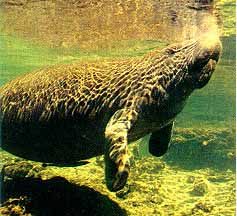Amazonian Manatee (Trichechus inunguis)
Class: Mammalia Order: Sirenia Family: Trichechidae Genus: Trichechus Species: Trichechus inunguis IUCN Status: Vulnerable
Photo Courtesy animalinfo.org
Amazonian Manatees (Trichechus inunguis) are only found in the fresh water rivers of the Amazon Basin. Manatee is an American Indian word meaning "Lady of the Water." In Ecuador, these manatees are listed as critically endangered; the highest distinction under the IUCN's endangered species classification ranking. They have been documented living in Anañgu Lake and its watershed as well as in the Yasuni River. Yasuni National Park is therefore one of the species' last refuges. It is likely Amazonian Manatees use the Tiputini River, which is the northern boundary of Yasuni, as a travel route
This unusual looking mammal is smaller in size than both the West Indian and West African Manatees. They are often described as looking like a cross between a hippopotamus and a seal. Their large bodies, which can reach lengths up to 9ft in length and weigh up to 3500 lbs, have front flippers similar to a seal's but have no hind limbs. Unlike other species of manatee, Amazonian Manatees have no nails on their flippers. This characteristic is denoted by its species name, inunguis, which means "no nails." Their bodies' rear sections are paddle shaped, flat, and rounded. This species is primarily grey in color although most Amazonian Manatees have a pink or white underbelly.
Amazonian Manatees do not have incisors or canine teeth, only molars designed to crush aquatic vegetation. Unlike other mammals, Amazonian Manatees continually form molars in the back of their jaws, which move forward to replace the front molars when they become worn and eventually fall out. In the dry season (September-March) they can fast for weeks or months when food plants are unavailable.
Female manatees can give birth to calves any time during the year. However, in the Ecuadorian Amazon, most births are reported in January and June. The gestation period is one year, with a calving interval of up to two years. Females carry their calves on their backs or close to their sides.
Amazonian Manatees are critically threatened in Ecuador due to habitat degradation, hunting, dynamite fishing and motor boats. Pollution from oil projects like the ones occurring in the Yasuni region also pose a major risk to the areas Amazonian Manatees.
CLICK HERE FOR MORE EXTRAORDINARY
ANIMALS and PLANTS OF YASUNÍ,
THE MOST BIODIVERSE FOREST KNOWN ON EARTH
Yasuní Biodiversity Main Page
|

